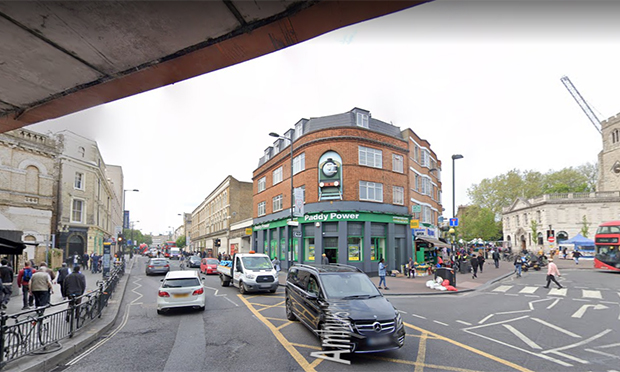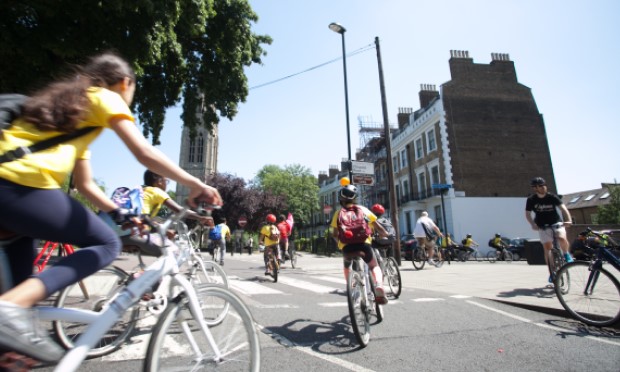‘Radical’ road closure plans drawn up for Hackney Central and Stoke Newington

Image: Google
Leading councillors are to consider further “radical plans” to close roads and filter traffic as the Town Hall’s drive to discourage the use of the private car continues under its emergency transport plan in response to Covid-19.
If bids to secure funding from Transport for London are successful, traffic filters letting through only buses, cyclists and pedestrians could be seen on Amhurst Road in Hackney Central and on Stoke Newington Church Street.
The aim is for people to walk and cycle in these areas as public transport capacity remains depressed.
Motor vehicles would still be able to get through to homes and businesses under the plans, but through-traffic would be restricted.
Cllr Jon Burke, who leads on transport for the council, said: “Our plans to rebuild a greener Hackney – through quieter, safer streets, new protected cycle lanes and cycle parking and expanded cycle training schemes – will support people who would normally take the bus or train to walk and cycle instead, especially as capacity on local buses remains at only 40 per cent of pre-lockdown levels.
“In doing so, we can help secure the kind of city we witnessed during lockdown, with cleaner air, less traffic and higher levels of walking and cycling.
“If just a fraction of people who used to use public transport return to their cars, it will exacerbate the air quality and road safety crisis we already had before lockdown, and prevent the 70 per cent of Hackney residents who don’t own a car from getting around safely.
“These plans are aimed at reducing this clear danger, and creating a better Hackney for everyone.”
It is understood that more information on the plans is set to be shared with residents subject to the outcomes of the funding applications.
According to the documents to be voted on next week, proposals under development for Hackney Central are aimed at reducing traffic for the socially distanced use of the town centre by shoppers, and for easier cycling conditions.
A bus gate is envisioned at Mare Street/Amhurst Road along with widened pavements in the area, with road closures planned at Wayland Avenue, Marcon Place, Navarino Road, Greenwood Road and Fassett Square, and an accompanying redesign of Pembury Circus junction.

Meanwhile a bus gate is also planned on Stoke Newington Church Street/Lordship Road, with modal filters planned for Yoakley Road and Bouverie Road on their junctions with Church Street, as well as Oldfield Road, Nevill Road and Lordship Road.
A large low traffic neighbourhood (LTN) bounded by Powerscroft Road, Clifden Road and the boundary with an existing LTN south of Redwald Road would also be created by plans to filter Chatsworth Road using a bus gate.
The Emergency Transport Plan is designed to create a whole new network of LTNS across the borough by reallocating road space, with filters aimed at eliminating through-traffic and rat-runs while seeking to maintain accessibility to residential streets.
It also includes plans for fast-tracked cycle lanes for Green Lanes, Queensbridge Road, and Seven Sisters Road, with a “significant expansion” of cycle training and cycle parking, including a 300-space hub for Shoreditch, and 40 traffic-calmed School Streets for almost every primary school in the borough, according to the council.
Recent changes to road layouts under experimental transport orders (ETOs) in the capital, which are time-limited, 18-month measures with concurrent consultation, have been hotly contested by many who have warned of increased congestion and inconvenience.
Responding to the plans for Hackney Central, Niall Crowley, who is part of the Horrendous Hackney Road Closures campaign group, which had hundreds of people take to the streets in protest against the measures over the weekend, said that while traffic in the area “has long been a headache”, there are alternative options to easing it rather than “simply closing it down”.
Crowley added: “Make it impossible to drive and the traffic will go away appears to be the desired outcome – make it impossible to drive and the traffic will go away. It seems an incredibly arrogant and foolhardy policy, playing with people’s lives in that way.
“I’ve been cycling around here for 20 years, and I’ve almost been run off my bike and assaulted I don’t remember how many times, and it would be great to accommodate that as best we can. I think that is something that has to be done in cooperation.
“There is a top-down thing happening where [the council] says, ‘We know what is best for you. We will treat you like children’. If you want to turn people off and turn them into passive recipients of whatever you give out, you’ll never have a healthy, active democracy. They talk about having active transport, but what about active citizenship?”
All on-street measures in Hackney will be implemented through ETOs, under which give residents get to have their say on how measures work in practice before any decision is made on whether or not to make them permanent, with changes recently made to the Hoxton West LTN in response to resident feedback and traffic monitoring.
In its strategy, the council stresses that the measures would allow residents and businesses to be able to access their properties, though potentially by a different route, with the Town Hall set to work with businesses to ensure any impact on their deliveries or services would be minimised.
Crowley added: “I live on Whiston and Laburnum, and it’s been hellish. What my response is supposed to be is, ‘Why haven’t you done my street?’, wanting us to blame traffic and say ‘Do more’, rather than just manage our traffic sensibly.
“It seems to me it is affecting people with families, who need to get kids into their cars on the school run. I think there is an intolerance there – I don’t like cars going down my road all the time, but being part of a community is dealing with things that other people do that you don’t necessarily like.
“That would be my starting point – to what degree can we put up with things that will help us live together?”
The government has laid out guidance for Town Halls calling on all local authorities to make “significant changes” to road layout to increase space for cyclists and pedestrians, which it says aim to “embed altered behaviours and demonstrate the positive effects of active travel”.
According to the council’s strategy, the measures have all been designed to ensure that nowhere currently accessible by car by locals and delivery vehicles would become inaccessible, with transport for those with special educational needs and disabilities (SEND) to be “considered carefully”.
Residents around every closure will now be getting letters outlining how to have their say on the schemes, with a “comprehensive engagement study” being drawn up by the Town Hall.
Burke added: “Many of the transport projects contained within the Hackney emergency transport plan are very much part of the vision of the existing Transport Strategy. Some of the planned projects have been supported by local residents for many years.
“The key difference between the two is the significant acceleration in ambition as a direct response to the present coronavirus crisis and its potential to magnify a number of major challenges for the borough in terms of air quality, road safety, and rapid global warming.
“The decisions we make today will determine our success in tackling those urgent challenges. The prize at stake is a cleaner, safer, and more secure future for our residents and their children. Now is the time to be bold, face the future, and deliver the positive, transformational change that the people of Hackney deserve.”
